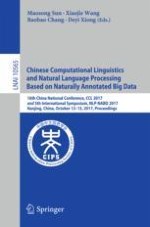2017 | Buch
Chinese Computational Linguistics and Natural Language Processing Based on Naturally Annotated Big Data
16th China National Conference, CCL 2017, and 5th International Symposium, NLP-NABD 2017, Nanjing, China, October 13-15, 2017, Proceedings
herausgegeben von: Maosong Sun, Xiaojie Wang, Baobao Chang, Deyi Xiong
Verlag: Springer International Publishing
Buchreihe : Lecture Notes in Computer Science
